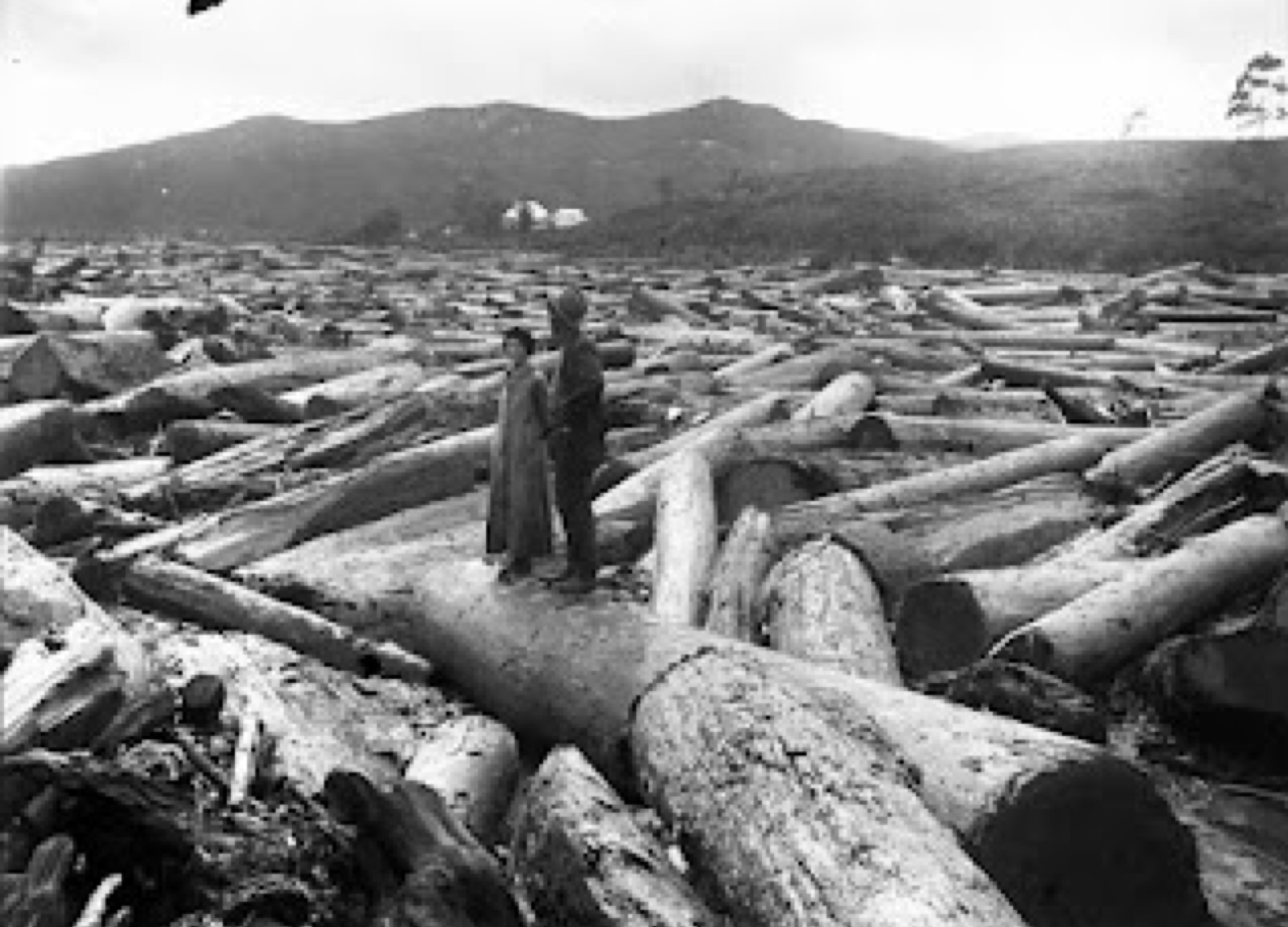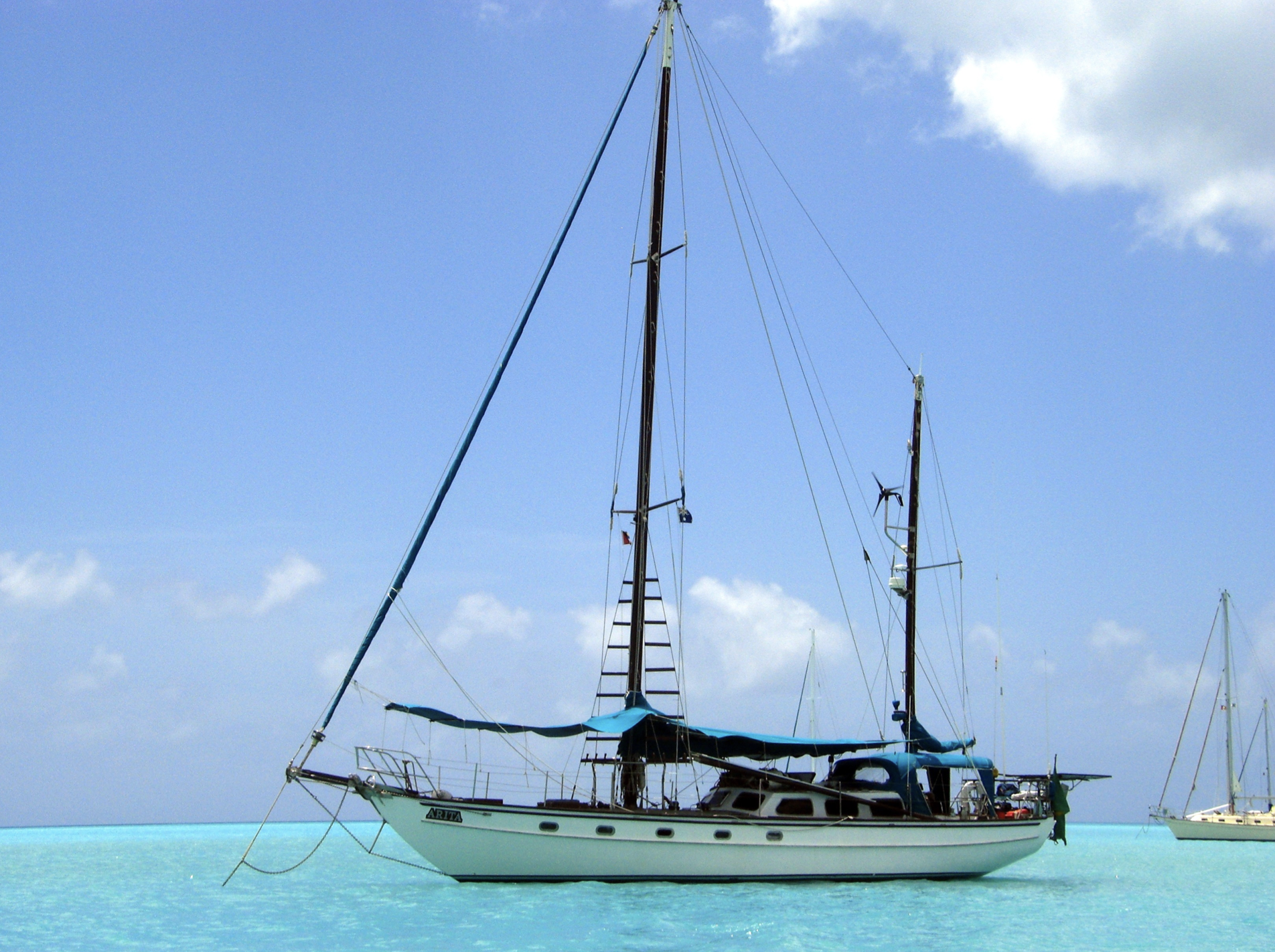The Wooden Yacht ARITA
By Rob Dehaan
In today’s world, it is really unbelievable how many magnificent “KAURI” trees were felled in New Zealand and the Pacific Islands, including on Frazer Island (K’Gari) on the Queensland coast in Australia. It is a fantastic species of straight-grained pine with few branches that proved to be excellent for boat building, notwithstanding that the majority of the logs were shipped to England for house and floor construction.
By the late 1950s, most forests were very much depleted and attempts were made to retrieve logs lost along the coast or found in swamps. Some of those were found to be perfectly preserved, including one, that was carbon dated at 12,000 years old.
One of the remaining trees was this 700 year old specimen, bought and felled by the late Dick McIlvride whose goal was to build an all-Kauri 47-foot ketch to the plans of the naval architect John Alden.
The sheer size of it can be seen from the photograph with Dick’s family at the base of the tree. The idea of using full 60ft planks was abandoned when the logging truck jammed on a bridge and the police ordered it to be cut into two pieces after blocking traffic for three days. Not that there is anything wrong with 30-foot planks.
While the planks were drying in the sawmill, I believe it is customary in NZ when building a yacht to select a paddock, dig a big hole, put in some formwork, throw some concrete around it and go to town to collect all the scrap lead you can find.
Then line up a copper pot, probably left over from the whaling days, melt down the window counter weights, battery scrap to the tune of six tons and pour it into the mould.
Next step, drag the keel onto a barge, float it to the railway at the boatyard, transfer it onto a dolly and carefully position it into the boatshed, where the copper tubes in the lead keel are drilled out to take the eventual stainless-steel keel bolts, once the king plank is installed.
The Kauri planks are used to make the frames, stringers are added, then the process of planking the hull and caulking her. An exacting job by Dick and his crew in Deeming’s boat shed, Opua.
After launching “Arita”, she is hauled to a nearby beach to complete the interior, install masts and rigging and do sea trials. “Arita” becomes the first yacht to circumnavigate New Zealand along Captain Cook’s route, together with the yacht “Treasure” owned then by John Guzzwell.
Dick McIlvride takes her further, sailing to Fiji, Tonga, the Cook Islands and onto Papeete, in French Polynesia, before returning to New Zealand.
Despite going through a series of owners, “Arita” ends up eventually in Cape town, South Africa, where I become involved in the next seventeen years of ownership. I spot her in the docks at Royal Cape Yacht Club, a name far more regal than its surroundings, due to the constant passing of coal fired locomotives. I buy her from the owner with a handshake and by giving him my pocket knife as a deposit, which in turn causes his wife to label me as “ a fruitcake” until the real money is presented after the weekend. I figure that this wooden Classic is a once in a lifetime opportunity, and I forgo survey on the basis that whatever maybe wrong I can fix it. A love affair begins, for which there are few words that can truly encompass the feeling that wooden boat owners have. Sailors in Cape town generally do not go out to do racing unless the wind is at least 30 knots. You cannot get over the crests that roll in from the Antarctic unless there is decent wind and the more the better. “Arita” handles it well, though with tremendous weather helm, a problem I solve by putting a bowsprit on her, and in the process add a furling headsail, an all-weather dodger, solar panels and an inverter.. Life on board is now even more beautiful. Under each bunk is a jigsaw puzzle of little wood pieces. It is then, that a sailor shows me some NZ yachting magazine articles featuring “Arita”. I come to terms with her origins, and it explains why I have an Aussie three pin plug outlet in the galley. I contact Dick, send him photos and in a phone call he comments about the bowsprit “ She needed that”. Say no more.........
I sail her out of Africa via Namibia, St. Helena island, across the South Atlantic to Brazil and slowly past the Amazon to the Caribbean. As pride would have it , I join in the Antigua wooden boat Classic regatta, where she is dwarfed in size and splendor by the World’s best. I criss-cross with three-masted schooners, sailed by millionaires, whose security detail comes from Nepal and J-Class 1930s super yachts like “ Endeavour “ and “ Velsheda” on opposite tacks. A sight to behold. A sight to rob you of all dignity and standing. Humbling.
Nevertheless , after going through two hurricanes in Nelson’s Harbour, Antigua and surviving, I sail my beautiful “Kauri” yacht to Florida and enter the land of indescribable plenty. Motoring along the East Coast intercoastal, past the estates of the like of Greg Norman, all I can do is point to my little Aussie yard-arm flag, while waving at ten acres of the neatest and most luxurious grass in the world and seeing no one..
I could go on, but nostalgia forbids it. Sometime later , very much later, in the Caribbean “ Arita” is lost in a hurricane that hits Puerto Rico. The new owner had promised me she would be treasured and would outlive him. He lied.













